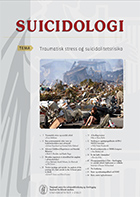Hvordan organisere et akuttilbud for ungdom i selvmordsrisiko?
DOI:
https://doi.org/10.5617/suicidologi.2172Sammendrag
Selvmordsrisiko er en av de vanligste grunnene til henvisning til psykiatriske akuttavdelinger for ungdom. Ved Ungdomsseksjonen for øyeblikkelig hjelp i Drammen har en gjennom flere år arbeidet med fleksible løsninger for ungdom med akutt selvmordsrisiko. Behandlingen kan skje gjennom innleggelse, polikliniske samtaler eller ambulante tiltak. I 2005 deltok seksjonen i Multisenterstudien for akuttpsykiatri (MAP-studien). Sentrale spørsmål i studien var: Hva kjennetegner pasientene? Hvilken sammenheng er det mellom vurdert selvmordsrisiko og valg av behandlingsnivå? Hvordan operasjonalisere prinsippene tilgjengelighet, fleksibilitet, kontinuitet, familie og nettverk i behandlingen av unge mennesker i selvmordsrisko? Her presenteres noen av dataene seksjonen samlet inn under MAPstudien, samt hovedprinsippene som er fulgt, illustrert med ulike case. Artikkelen beskriver hvordan man kan gi et poliklinisk/ambulant tilbud til ungdom med forhøyet selvmordsrisiko. Suiciderisk among adolescents – how to help in an acute phase and after Risk of suicide is one of the most frequent reasons for psychiatric referrals of patiens between 13–18 years in the Child and Adolescent Mental Health Services (CAMHS). The clinical picture is compound and hetero-geneous because psychiatric symptomes are less marked than in adults and phenomenons like insecurity, unstability and impulsivness are more common. In 2005, Ungdomsseksjonen for øyeblikkelig hjelp, an acute emergency unit for adolescents, participated in a multi-centre study of five acute CAMHS. The study clarified some of the principles of intervention and the article presents theese principles illustrated with cases and with data collected in the multicentre study. The service is organised in a unit providing both outpatient (home treatment or consultation with therapists) and inpatient treatment. Mobilising parents and relatives based on a familiy- and network therapeutic approach, is fundamental in the treatment irrespective of where the patient recieves the treatment. The organization of the psychiatric emergency services to children and adolescents should aim for flexibility and availability and offer both inpatient and out-patient treatment. In this way one can adjust the service by severity of mental illness and in cooperation with and support from the family and the network.Nedlastinger
Publisert
Utgave
Seksjon
Lisens
Dette tidsskriftet gir umiddelbar og fri tilgang (Open Access) til tidsskriftets innhold, ut fra det prinsipp at det å gjøre forskning fritt tilgjengelig for allmennheten gir økt global utveksling av kunnskap.
Forfattere som publiserer i dette tidsskriftet aksepterer følgende vilkår:
1. Forfatter beholder opphavsrett til sine verk i henhold til Åndsverkloven, og gir Suicidologi rett til første publisering av et verk.
2. Forfatter kan inngå separate tilleggsavtaler om ikke-eksklusiv distribusjon av den publiserte utgaven av sine artikler (f.eks. levere den inn til et institusjonelt publiseringsarkiv) så lenge Suicidologi blir kreditert som første utgiver.
3. Leseres bruk av tidsskriftet må skje i tråd med Åndsverkloven.


